Organic carbon content and carbon isotope variations across the Permo-Triassic boundary in the Gartnerkofel-1 borehole,Carnic Alps,Austria
2018-07-04BrookfieldWolbachStebbinsGilmourRoegge
M.E.Brookfield•W.S.Wolbach•A.G.Stebbins•I.Gilmour •D.R.Roegge
1 Introduction
The Gartnerkofel borehole is one of the most thoroughly studied and described Permo-Triassic sections in the world(summary in Holser et al.1989,1991).Although Klein(1991)included organic carbon contents in his more inclusive study of elements,the results of detailed organic carbon isotope studies across the PTr boundary in the core have only been reported in a brief abstract(Wolbach et al.1994).In view of the importance of such studies in other Permo-Triassic sections,this paper summarizes these analyses of the total Gartnerkofel organic carbon,organic carbon isotopes,together with carbonate carbon and oxygen isotopes from Magaritz and Holser(1991),compares them with the total organic carbon analyses of Klein(1991)on the same samples,and compares our Gartnerkofel carbon patterns to other Permo-Triassic Tethyan sections.
2 Geology
The Gartnerkofel core was drilled in 1986 near the western end of the Permian Tethys Sea in a shallow-water shelf area interpreted as a currently eastward facing carbonate ramp(Brandner et al.2009)(Figs.1,2).
Over most of its outcrop,the Late Permian Bellerophon Formation consists of thick carbonate-sulphate succession deposited in marginal(sabkha)to shallow shelf marine conditions with the top~1 m(Bulla member)consisting of more normal marine highly fossiliferous dark bioclastic wackestone,packstone and interbedded thin marls limestone with calcareous algae,foraminifera,mollusks and brachiopods(Noé1987;Farabegoli et al.2007).A top erosional surface on the Bulla Member is sharply overlain by the Tesero member of the Werfen Formation,which consists of diverse micrite,microbialites and marls interbedded with oolitic,peloidal and bioclastic packstones(Farabegoli et al.2007).The Tesero member blankets the underlying diverse Bulla Member facies,and varies little and irregularly(between 3 and 5 m)across the entire area,though it is absent between Bulla and Gartnerkofel(Noé1987).
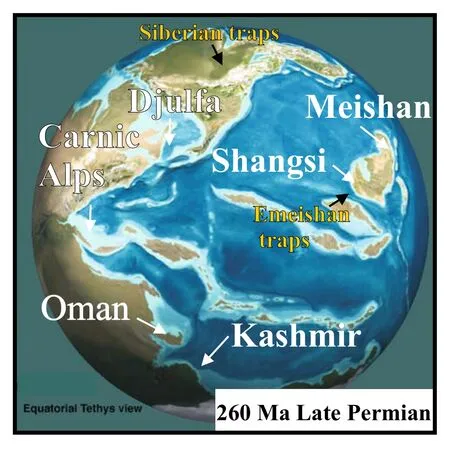
Fig.1 Late Permian palaeogeography(courtesy Ron Blakey)with places cited
The previously proposed carbonate ramp interpretation of the Tesero oolite section(Brandner et al.2009)is incompatible with the limited thickness and facies variations shown in the sections,and with the juxtaposition of very different sections across Alpine thrusts,with large translations of tens of km,within the Dolomites(Doglioni 1987).Thusthe Tesero ooliteismissing in the San Antonio section though present in the thrust sheets on either side(Fig.2).Furthermore the ramp interpretation(as shown in Fig.2b)is arbitrarily based on arranging Tesero oolite sections and the burrowed datum on which they rest,in a line downstepping to the east:the thinning of the lowermost oolite from Tramin to Gartnerkofel(interrupted by the fault-enclosed San Antonio section)is typical of carbonate platforms like the Bahama Bank,where marginal oolite shoals thin and pass into pelletoidal finer sediments towards the interior of the platform(Harris et al.2015).A flat carbonate platform environment fits the lack of horizontal but marked vertical facies change(during sea level variations)far better,and was the interpretation shown by Noé(1987)in the first comprehensive study of the PTr boundary sections in the area(Fig.2c).
Furthermore,the Permian paleomagnetism of the Dolomites shows around 50°anticlockwise rotations of the southern Alps relative to central Europe during large post-Permian lateral movements and disruption of the Adria block(Muttoni et al.2013)and can thus not be compared to units now adjacent to it,like the Lombardy Verrucano to the west across the Judicaria fault(Gaetani 2010).
The biodiversity drops markedly at the Bulla/Tesero contact but Permian brachiopods and bivalves persist into the Tesero Member(Posenato 2009).The first appearance datum(FAD)of the conodont Hindeodus parvus which defines the base of the Triassic is at 6 m above the base of the Tesero Member at Gartnerkofel,but only 2 m above the base at Bulla(Schönlaub 1991)(Fig.2).
The main lithological change(the Late Permian Event Horizon,LPEH)from the Bulla to the Tesero Members thus does not co-incide with the main extinction,nor with the base of the Triassic as defined by H.parvus.The strata between the LPEH and the base of the Triassic are thus of great interest for interpreting environmental changes associated with the extinction.
3 Materials and methods
One set of PTr samples were used for all Gartnerkofel geochemical analyses(Klein 1991).
3.1 Wolbach and Gilmour methods
To cover the PTr boundary adequately,bulk C residues were isolated from samples between 115.95 and 330 m depth in the core,using HCl and HF–HCl procedures of Wolbach and Anders(1989).Organic carbon wasseparated from any elemental carbon using extended acid dichromate oxidation(Wolbach and Anders 1989).Residues were combusted to CO2for mass-spectrometric analysis,yielding isotopic data,and weights for organic carbon.Carbon isotopes were measured on a VG SWIRA 24 mass spectrometer using sealed-tube combustion.
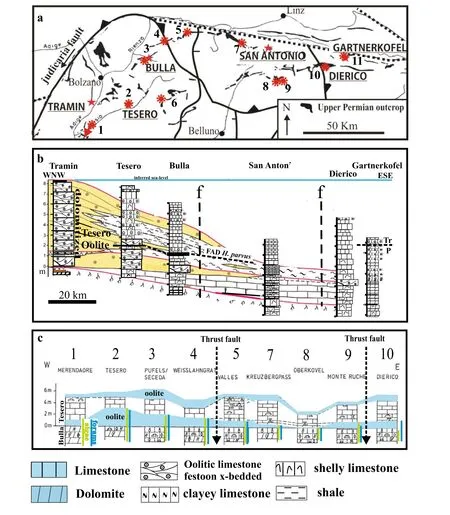
Fig.2 a Location of Gartnerkofel and other PTr sections in the Dolomites,southern Alps.b Reconstructed cross-section of the Early Triassic carbonate ramp at the end of Tesero oolite deposition(after Brandner et al.2009,Fig.8),with representative sections.Note that the only the Tramin,Tesero and Bulla sections are in the same tectonic unit,the other sections are across thrust faults,and actual thickness variation is nowhere greater than 5 m across a horizontal distance of over 130 km.c Thickness variation and persistence of Bulla and Tesero Oolite facies from west to east(from Noé1987).Source:Stratigraphic columns:Tramin:Brandner et al.(2012);Tesero:Posenato(2009);Bulla:Farabegoli and Tonidandel(2012),Posenato(2009);San Antonio;Brandner(1988);Kraus et al.(2013);Dierico:Buggisch and Noé(1986);Gartnerkofel:Holser et al.(1991)
3.2 Klein(1991)methods
The carbon content was analyzed on separate aliquots of the powdered samples.For determination of total carbon(Ctot)a 100 mg portion was weighed into a ceramic crucibleby electronic balance.With aglassspoon about 2 g of LECOCEL(a Sn-W alloy)and 1 g of steel(7 ppm C,14 ppm S)were added.The mixture was combusted in a furnaceat 1400 °C,using oxygen(> 99.5%pure)ascarrier gas.The evolved gas CO2was measured in infrared cells by integrating its peaks.The system was calibrated with LECO calibration samples and with internal laboratory standard Bellerophon Dolomite A/1.
Each sample was analyzed two to four times.The relative standard deviations were<1%for C.For determination of organic carbon(Corg),500 mg of powder were weighed into a porous filter crucible,leached three times with 8 mL 2 M HCl,rinsed ten times with deionized water,and filtered with a filtering flask.The crucibles were dried in an oven at 150°overnight.Measurements were carried out as for total C.Acid-soluble carbon(Ccarb)was calculated by difference.
4 Results
Total organic carbon and organic carbon isotopes of our study,together with the total organic carbon of Klein(1991),and carbonate carbon and oxygen isotope resultsof Magaritz and Holser(1991),plus the Sandδ34Sresults of Pak and Holser(1991)are shown on Table 1 and Fig.3.In our study,the brown color of all carbonaceous residues and rapid disappearance of residue aliquots on dichromate oxidation,together with their carbon content(~100%);indicate that the residues were composed entirely of organic carbon.The organic carbon content of the sediments was relatively low(<2000 ppm)except at 216 m(> 5000 ppm),and at 215 and 268 m(> 2000 ppm)(Table 1,Fig.3).These high valuescorrespond with lower negativeδ13Corgvalues,which are in keeping with their inferred oceanic origin,as these samples were easily oxidized by dichromate—residual land-derived organic matter is much more difficult to destroy(Wolbach et al.1994).The total organic carbon results of Klein(1991)are divergent from ours and tend to be an order of magnitude higher(Table 1).The reasons for this are not entirely clear(we could not contact Peter Klein for comment),but could be due to:(a)sampling differences—unlikely,as we analyzed the same layers;(b)mineral acid differences—2 M HCl for Klein,9 M HCl followed by 15 M HF/1 M HCl for Wolbach,more aliphatic organic carbon would be destroyed by these methods—which would explain the lower Wolbach values;(c)destruction of silicates—by dissolving silicates,Wolbach freed up any carbon bound by the silicate crystal structure itself that carbon fraction would have been measured by Wolbach,but not by Klein—again this does not explain the lower Wolbach values;(d)oxidation—Wolbach made a concerted effort to destroy organics,then determine their isotopic values by difference whereas Klein measured organics directly,which might have missed silicate-encapsulated organics,but included any elemental carbon present with his Corgdata and assumed it to be organic.
Nevertheless,the trends are the same in both analyses and the total organic values are all low in any case(Table 1,Fig.3).
Our organic carbon isotopestudiesshow anegativebase shift of-24‰ to-28‰ in the upper Bellerophon Formation to-26‰ to-28‰ in the Tesero Member,which latter values persists into the earliest Triassic Mazzin Member,after which it decreases slightly to-26‰(Table 1,Fig.3).Superimposed on this are two sharp negative peaks of> -38‰ in the Latest Permian(at 286.33 and 252 m depth)and a broader negative peak of>-31‰ (215.07–207.14 m depth)in the Early Triassic(Fig.3).The two negative peaks in the upper Bellerophon Formation are not recorded in Wolbach et al.(1994)as they did not plot the values below 242 m.
Theδ13Ccarbvalues show a gradual drop from the Bellerophon through the Tesero Member into the lower Mazzin Member,followed by subdued fluctuations(Fig.3).This is consistent with the general average worldwide drop of-2‰across the PTr boundary(Korte et al.2001).
Theδ18Ocarbvalues also show a gradual drop from the Bellerophon into the Tesero Member after which they remain fairly constant until some zigzags in the lower Mazzin Member at the same level as the organic carbon zigzag(Fig.3).Although these beds show both Early and Late dolomitization(Boeckelmann and Magaritz 1991),and the oxygen isotopes therefore unlikely to be primary,and though the Gartnerkofel values are whole rock values,the significant fluctuations suggest that the oxygen isotopes in the section have not been homogenized.Under meteoric diagenesis Phanerozouc carbonate rocksshow elevated Mn and decreasing Sr contents due to dissolution of primary carbonate and precipitation of carbonate cements(Brand and Veizer 1980):carbonate samples with Mn/Sr ratio of<10 might still retain their primary isotopic signatures(Kaufman and Knoll 1995).All Gartnerkofel samples studied have Mn/Sr ratios of<5(data of Klein 1991).
It isinteresting that thegeneral warming trend acrossthe Tesero Member is compatible with the warming across thePermian–Triassic boundary in China inferred from conodont apatite(Sun et al.2012).The calculated seawater temperatures for Gartnerkofel based on Sun et al.’s(2012)methods,but using bulkδ18Ocarbvalues,show a low of-10 °C in the Ostracod unit rising to+6 to+26 °C in the overlying units.The Ostracod unit temperatures are unreasonably low,but may be caused by variable salinities in this sabkha-type environment(Mette and Roozbahani 2012).The higher temperatures are not inconsistent with a modern tropical carbonate environment like the Persian Gulf,where the lagoons and the open ocean can reach 24–32 °C and the coastal sabkhas can occasionally dip as low as 0°C(Al-Farraj 2005;Warren 2006).

Table 1 Carbon,carbonate and organic carbon isotope,and su8lfur and sulfur isotope data for the Gartnerkofel core
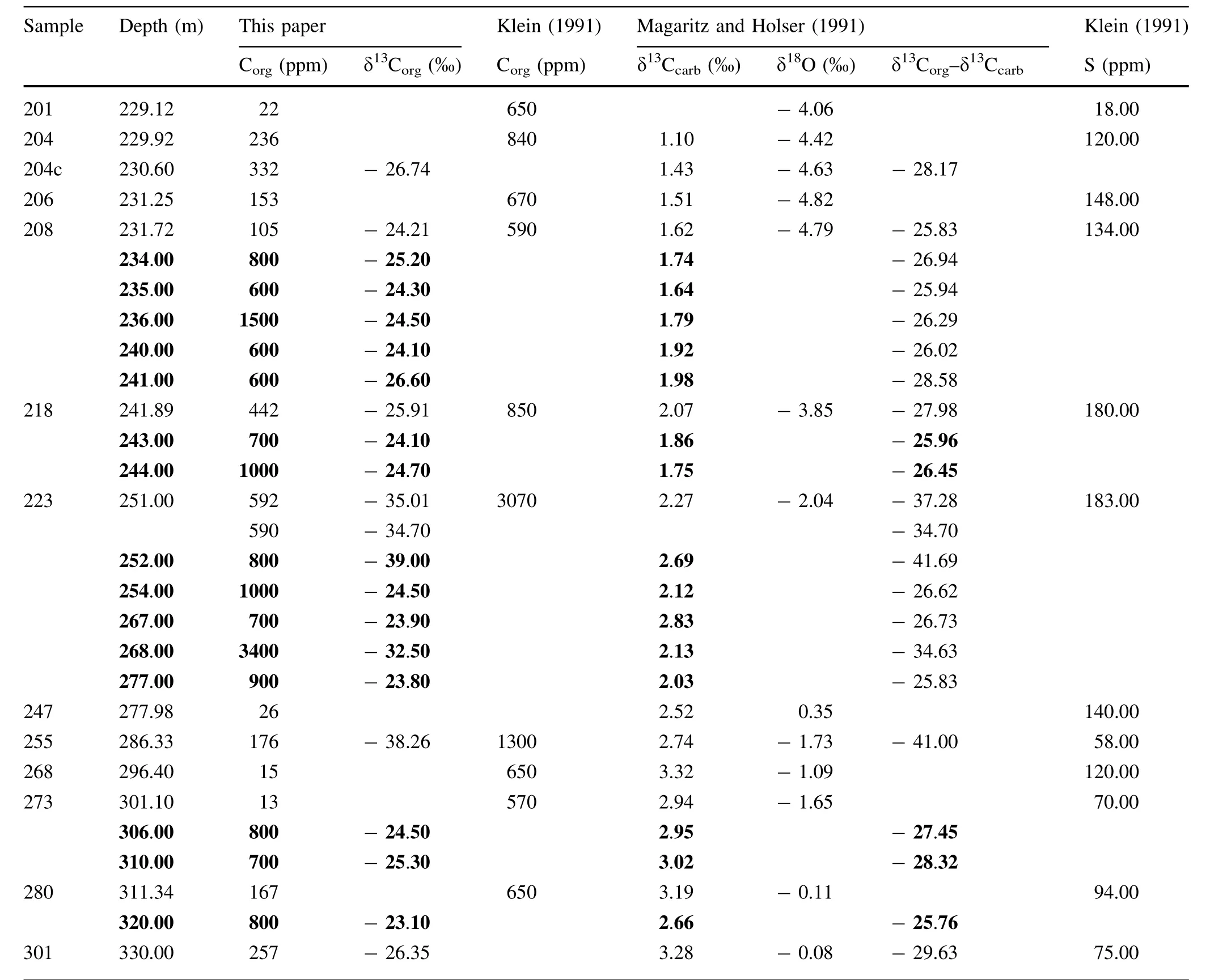
Table 1 continued

Fig.3 Late Permian to Early Triassic section of Gartnerkofel core(Holser et al.1991;Schönlaub 1991);organic carbon and organic carbon isotope plots(this study);organic carbon plots from data in Klein 1991);carbonate and oxygen isotope plots from data in Magaritz and Holser(1991);Sand Sisotope plots from data in Klein(1991),Pak and Holser(1991)(see Table 1).Note expanded scale from 232 to 222 m depth
δ34S values of pyrite reflect the relative abundance of pyrite that formed within the water-column(syngenetic)and within the sediments(diagenetic),with lower values generally reflecting an increase in syngenetic pyrite due to anoxic or euxinic waters.The Tesero Member of the Bulla PTr section contains two relative minima inδ34Svalues of sulfide around-30‰with increases in S concentrations and S/Corgratios(Gorjan et al.2007).The values in these intervals reflect an anoxic or euxinic water-column in the Tesero Member(Gorjan et al.2007),and similar valuesare recorded at multiple locations after the LPEH(Shen et al.2016 and references therein).At Gartnerkofel,the sharp increase in Sconcentrations and low values ofδ34Sin the Mazzin Member suggests an additional anoxic or euxinic interval in the Early Triassic,extending the record of transient anoxic intervals from the Tesero Member of the Bulla section.
5 Discussion and comparisons
Carbon isotope fluctuations in marine carbonates and marine plankton reflect the dissolved inorganic carbon reservoir in seawater.Organic carbon isotope fluctuations reflect the proportions contributed by marine and continental organic matter as well as by the contribution of green sulfur bacteria growing in anoxic conditions—negative trends in organic carbon isotope values have been used to infer anoxia(Berner 2005).
The strong fluctuations inδ13Corgvalues across the Permian–Triassic boundary in Alpine sections are readily attributable to variations in the proportions of marine versusterrestrial organic matter(Krauset al.2013).Therange of values ofδ13Corgreported for modern terrestrial higher plants(average-26.1‰),differs greatly from those for modern marine phytoplankton(average-17.7‰)(Wickman 1952;Craig 1953;Smith and Epstein 1971).Changes in δ13Corgvalues of up to 6.0‰,(from ~ -19‰ to-25‰)were measured across the Pleistocene–Holocene boundary in cores from the Gulf of Mexico abyssal plain,reflecting increased transport of terrestrial plant remains from re-established Holocene lowland forests to the Gulf basin(Newman et al.1973).In the Quaternary,therefore,increased land plant input is marked by more negative δ13Corgvalues.
In contrast to modern organics,Permian plant material has heavier carbon isotope values(δ13C=-24‰)compared with Permian plankton such as acritarchs(δ13C=-30‰)(Faure et al.1990;Strauss and Peters-Kottig 2003;Herrmann et al.2012).The difference from modern situations is because plants with C4 metabolism(all angiosperms)which have higherδ13Corgvalues between-8‰ and-15‰,did not evolve until the Cretaceous(O’Leary 1988).Kraus et al.(2013)noted that the Alpine PTr sectionsfrom near shoreto offshoreshowed the same organic carbon isotope trends but that the more offshore sections showed lighter,more negative values,consistent with greater plankton and lesser land plant input.Furthermore,their zigzag fluctuations inδ13Corgof up to 4‰in the Tesero Member are most plausibly caused by variations in land versus marine organic content,especially as theδ13Ccarbvalues do not change much.In contrast to Kraus et al.’s(2013)results,however,our main zigzag fluctuations occur lower down in the Bulla Formation,while their fluctuations in the Tesero member(admittedly based on much closer spaced samples)are not seen in our Tesero Member samples(Table 1,Fig.3).
The two very negativeδ13Corgpeaks at 251/2(-35‰,-39‰)and 286 m(-38‰)depth at Gartnerkofel suggest marine incursions into the variable salinity Bellerophon sabkha environment.These extreme negativeδ13Corgvalues are,however,beyond the range of both mantlederived(δ13C=-5‰)and organic carbon,including sulphur bacteria(δ13C< -30‰)sources and require methane input(δ13C=-60‰)(Summons et al.1994;Higgins and Schrag 2006;Retallack and Krull 2006;Taipale et al.2015).Even the overlying Bulla and Werfen values need either almost pure marine organic sources or methane input—but the methane would need to be metabolized by organisms.One possibility is that the recently discovered ‘methane-eating’Methylobakter is responsible(Ettwig et al.2010).Since these use nitrate reduction in their metabolism,then they might be detected from nitrogen isotope studies(to be done).
Smallerδ13Corgfluctuations also occur above 222 m depth where pyrite,sulfur and,shortly above,carbon content increase,with a marked shift to lighter,more negative marineδ13Corgvalues(Holser et al.1989),consistent with the continuing Early Triassic marine transgression.The subsequent shift to heavier less negative values above 207 m suggests input of land plant material during the earliest Triassic which is recorded in other Alpine sections(Sephton et al.2002;Gorjan et al.2008).
The Val Badia section shows greatδ13Corgfluctuations during Late Permian Tesero Member times with a more detailed sampling than Gartnerkofel(Fig.4).In fact,all the PTr boundary section along both the southern and northern sides of the Neotethys and on the South China microcontinent show marked positive shiftsinδ13Corgvaluesthough not necessarily at the same time if the correlations are accurate(Figs.4,5).If caused by greater land plant input,however,and if they are synchronous,then the positive shift is consistent with the destruction of land ecosystems and vegetation burning at this time,and with the marked negative shift inδ13Ccarbat this time(Grasby et al.2011;Retallack 2013).
In Kashmir In the transitional beds equivalent to the lower Tesero Member,zigzags inδ13Corgvalues(from-27‰ to-23‰)(Algeo et al.2007)are due to values from the background clays(more negative)and bioclastic beds introduced from shallower water(less negative)(Fig.4).In China,both Meishan and Shangsi show similar negative shifts in δ13Ccarbbut the δ13Corgshows somewhat divergent trends(Fig.5).The Meishan section is,however,very condensed with several erosion surfaces which juxtapose very different isotope values:missing sediments needs to be taken into account(Zheng et al.2013).
杨鹏幼时所居住的房子,是一座四百多平方米的围屋。童年时的杨鹏,性格很内向,也很孤独,因此,这一时期的他特别爱幻想。小小的孩子,大大的房间,难免心生恐惧之感。孤独内向的孩子,向外很难寻求慰藉,只能向内寻求力量。害怕之时,又有哪个孩子不希望有个英雄能来拯救自己呢?又有哪个孩子不想让自己成为拯救他人的英雄呢?好在,书本给了杨鹏战胜孤独与恐惧的力量。
In all Tethyan sections noted here,the δ13Corg–δ13Ccarbvalues are greater in the shallower water sections like Gartnerkofel and Val Badia than in the deeper shelf sections at Guryul ravine,Shangsi and Meishan(Figs.4,5),which is in keeping with the decreasing continental input noted in the Alps(Kraus et al.2013).
If the zigzags in the organic carbon isotope curves between the LPEH and the base of the Triassic are due to different proportions of land-and marine-derived organic matter,then either a number of marine transgressions and regressions need to be considered(as they have in the past—e.g.Brandner et al.2009)or climatically-or eventcontrolled variations need to be considered.
Though rapid eustatic changes of sea-level occur in glacial times,there is no evidence of a Latest Permian glaciation and,in fact,the evidence is for rapid and significant ocean warming at the time(Sun et al.2012;Song et al.2014),which would raise sea-level by many metres due to thermal expansion since a 1°C rise in mean ocean temperature raises sea-level by 2 m(Southam and Hay 1981).Rising sea level during warming and bringing more marine conditions over the area during deposition of the Tesero Member would explain the gradually lighter trends in both δ13Corgand δ13Ccarb.Climate warming is thus a possible control—but a marine transgression in the Latest Permian does not explain the spasmodic input of landderived vegetation at thetime,nor theextremenegativeδ13Corgvalues.
Input by backwash of land-derived material during storms,or even tsunamis,may explain some of the positive δ13Corgshiftsassociated with land vegetation input,even as far as the apparently isolated Bahamian-type Tesero oolite platform.Tsunami deposits have been identified in the Latest Permian in Kashmir,India(Brookfield et al.2013).Vast amounts of land-derived floating material were transported into and across the Pacific Ocean by the relatively small 2011 Japanese tsunami(Lebreton and Borrero 2013).The Tesero oolitic beds,with their hummocky cross-stratification and great extent(Brandner et al.2009)are also possible tsunamirather than simple storm deposits.
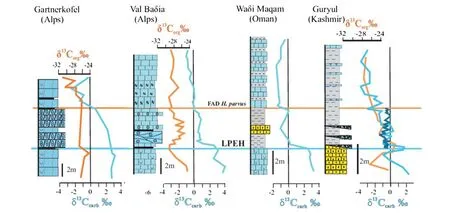
Fig.4 Comparison of Late Permian to Early Triassic organic carbon and carbonate Cisotopeplotsfor Gartnerkofel with variouslocalities along southern Tethyan margin(modified from Korte et al.2010)with additions and changes for Val Badia(Kraus et al.2013),Guryul(Baud et al.1996;Algeo et al.2007).Height between LPEH and base of the Triassic has been standardized for all sections
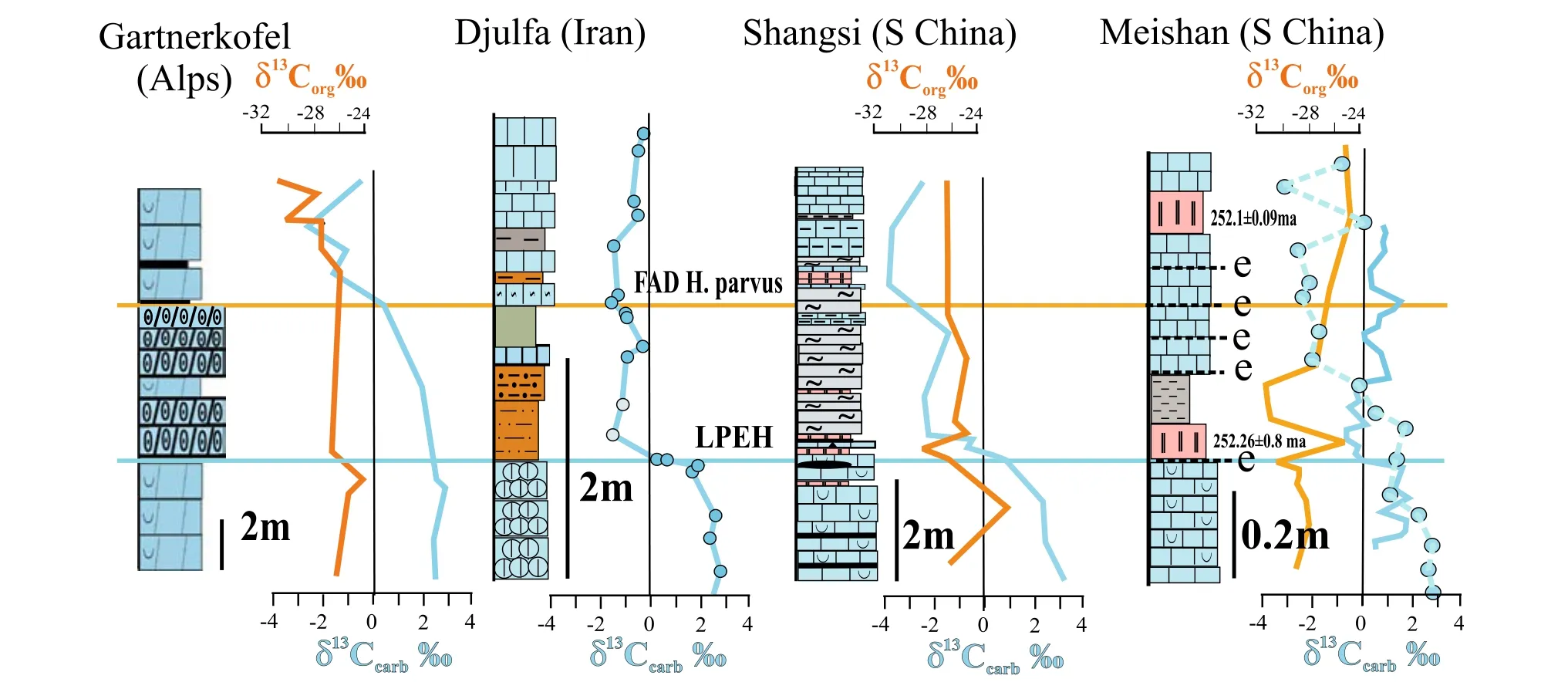
Fig.5 Comparison of Late Permian to Early Triassic organic carbon and carbonate Cisotopeplotsfor Gartnerkofel with variouslocalities along northern Tethyan margin and South China(modified from Korte et al.2010),with additions and changes for Djulfa(Kozur 2007;Ghaderi et al.2014),Shangsi(Wignall et al.1995;Jiang et al.2011;Riccardi et al.2007)Heping(Krull et al.2004).Height between LPEH and base of the Triassic has been standardized for all sections
6 Conclusions
A detailed carbon isotope curve across the Permian–Triassic boundary for the thoroughly studied Gartnerkofel coreshowsδ13Corgvaluesgenerally becomemorenegative upwards in parallel with theδ13Ccarbvalues showing that atmospheric and oceanic carbon dioxide controlled both.Several extremeδ13Corgexcursions,expressed in the δ13Corg–δ13Ccarbvalues are attributed to periodic input of land vegetation either by storms or tsunamis.The overall trend of both δ13Corgand δ13Ccarbvalues follow the other studied sections in the Alps and both northern and southern edges of the NeoTethys Ocean.
AcknowledgementsWe thank R.Schmitt for donating the samples and J.Gibson for making the Cisotope measurements.We appreciate the comments of Elke Schneebeli-Hermann on an earlier draft of the manuscript.
Compliance with ethical standards
Conflict of interestAll authors declare that they have no conflict of interest.
Al-Farraj A(2005)An evolutionary model for sabkha development on the north coast of the UAE.JArid Environ 63:740–755
Algeo TJ,Hannigan R,Rowe H,Brookfield ME,Baud A,Krystyn L,Ellwood B(2007)Sequencing events across the Permian–Triassic boundary,Guryul Ravine(Kashmir,India).Palaeogeogr Palaeoclimatol Palaeoecol 252:328–346
Baud A,Atudorei V,Sharp Z(1996)Late Permian and Early Triassic evolution of the northern Indian margin:carbon isotope and sequence stratigraphy.Geodinamica Acta(Paris)9:57–77
Berner RA(2005)The carbon and sulfur cycles and atmospheric oxygen from Middle Permian to Middle Triassic.Am J Sci 69:3211–3217
Boeckelmann K,Magaritz M(1991)The Permian–Triassic of the Gartnerkofel-1 core(Carnic Alps,Austria):dolomitization of the Permian–Triassic sequence.Abh Geologischen Bundesanstalt 45:61–68
Brand U,Veizer J(1980)Chemical diagenesis of a multicomponent carbonate system,1.Trace elements.J Sediment Petrol 50:1219–1236
Brandner R(1988)The Permian–Triassic boundary in the Dolomites(Southern Alps,Italy),San Antonio section.Ber Geologischen Bundesanstalt 15:49–56
Brandner R,Horacek M,Keim L,Scholger R(2009)The Pufels/Bulla road section:deciphering environmental changes across the Permian–Triassic boundary to Olenekian by integrated litho-,magneto-and isotope stratigraphy.A field guide.Geol Alp 6:116–132
Brandner R,Horacek M,Keim L(2012)Permian–Triassic-boundary and lower Triassic in the Dolomites,Southern Alps(Italy).JAlp Geol 55:375–400
Brookfield ME,Algeo TJ,Hannigan R,Williams J,Bhat GM(2013)Shaken and stirred:seismites and Tsunamites at the Permian–Triassic boundary,Guryul Ravine,Kashmir,India.Palaios 28:568–582
Buggisch W,NoéS(1986)Upper Permian and Permian–Triassic boundary of the Carnian(Bellerophon Formation,Tesero horizon,northern Italy).Mem Soc Géol d’Italia 34:91–106
Craig H(1953)The geochemistry of the stable carbon isotopes.Geochim Cosmochim Acta 3:53–92
Doglioni C(1987)Tectonics of the Dolomites(Southern Alps,northern Italy).JStruct Geol 9:181–193
Ettwig KF,Butler MK,Le Paslier D,Pelletier E,Mangenot S,Kuypers MMM,Schreiber F,Dutilh BE,Zedelius J,De Beer D,Gloerich J,Wessels HJCT,Van Alen T,Luesken F,Wu ML,Van De Pas-Schoonen KT,Op Den Camp HJM,Janssen-Megens EM,Francoijs KJ,Stunnenberg H,Weissenbach J,Jetten MSM,Strous M(2010)Nitrite-driven anaerobic methane oxidation by oxygenic bacteria.Nature 464:543–548
Farabegoli E,Tonidandel D(2012)Stratigrafia e facies al limite Permianao-Triassico nell dolomite occidentali(Provincia di Bolzano,Italia):una revisione.Geol Alp 9:120–155
Farabegoli E,Perri MC,Posenato R(2007)Environmental and biotic changes across the Permian–Triassic boundary in western Tethys:the Bulla parastratotype,Italy.Glob Planet Change 55:109–135
Faure G,Mensing TM,Taylor EL(1990)Carbon isotope composition of Permian and Triassic plants in silicified peat,Transantarctic Mountains.Antarct JRev 1990:26–27
Gaetani M(2010)From Permian to Cretaceous:Africa as pivotal between extensions and rotations of Tethys and Atlantic Oceans.JVirtual Explor.https://doi.org/10.3809/jvirtex.2010.00235
Ghaderi A,Leda L,Schobben M,Korn D,Ashouri AR(2014)Highresolution stratigraphy of the Changhsingian(Late Permian)successions of NW Iran and the Transcaucasus based on lithological features,conodonts and ammonoids.Foss Rec 17:41–57
Gorjan P,Kaiho K,Kakegawa T,Niitsuma S,Chen ZQ,Kajiwara Y,Nicora A(2007)Paleoredox,biotic and sulfur-isotopic changes associated with the end-Permian mass extinction in the western Tethys.Chem Geol 244:483–492
Gorjan P,Kaiho K,Chen ZQ(2008)A carbon-isotope study of an end Permian mass-extinction horizon,Bulla,northern Italy:a negativeδ13C shift prior to the marine extinction.Terra Nova 20:253–258
Grasby SE,Sanei H,Beauchamp B(2011)Catastrophic dispersion of coal fly ash into oceansduring the Latest Permian extinction.Nat Geosci 4:104–107
Harris PM,Purkis SJ,Ellis J,Swart PK,Reijmer JJG(2015)Mapping bathymetry and depositional facies on Great Bahama Bank.Sedimentology 62:566–589
Herrmann E,Hochuli PA,Bucher H,Roohi G(2012)Uppermost Permian to Middle Triassic palynology of the Salt Range and Surghar Range,Pakistan.Rev Palaeobot Palynol 169:61–965
Higgins JA,Schrag DP(2006)Beyond methane:towardsatheory for the Paleocene–Eocene thermal maximum.Earth Planet Sci Lett 245:523–537
Holser WT,Schönlaub H-P,Attrep M Jr,Boeckelmann K,Klein P,Magaritz M,Orth CJ,Fenninger A,Jenny C,Kralik M,Mauritsch H,Pak E,Schramm J-M,Statteger K,Schmöller R(1989)A unique geochemical record at the Permian/Triassic boundary.Nature 337:39–44
Holser WT,Schönlaub H-P,Boeckelmann K,Magaritz M(1991)The Permian–Triassic of the Gartnerkofel-1 core(Carnic Alps,Austria):synthesis and conclusions.Abh Geologischen Bundesanstalt 45:213–232
Jiang H,Lai X,Yan C,Aldridge RJ,Wignall P,Sun Y(2011)Revised conodont zonation and conodont evolution across the Permian–Triassic boundary at the Shangsi section,Guangyuan,Sichuan,South China.Glob Planet Change 77:103–115
Kaufman AJ,Knoll AH(1995)Neoproterozoic variations in the C-isotopic composition of seawater:stratigraphic and biogeochemical implications.Precambr Res 73:27–49
Klein P(1991)The Permian–Triassic of the Gartnerkofel-1 core(Carnic Alps,Austria):geochemistry of common and trace elements 1—ICP,AAS and LECO.Abh Geologischen Bundesanstalt 45:109–121
Korte Ch,Veizer J,Leythaeuser D,Below R,Schwartz L(2001)Evolution of Permian and lower Triassicδ13C in marine and terrigenous organic material.Terra Nostra 4:30–34
Korte C,Pande P,Kalia P,Kozur HW,Joachimski MM,Oberhänsli H(2010)Massive volcanism at the Permian–Triassic boundary and its impact on the isotope composition of the ocean and atmosphere.JAsian Earth Sci 37:293–311
Kozur HW(2007)Biostratigraphy and event stratigraphy in Iran around the Permian–Triassic Boundary(PTB):implications for the causes of the PTB biotic crisis.Glob Planet Change 55:155–176
Kraus SH,Brandner R,Heubeck C,Kozur HW,Struck U,Korte C(2013)Carbon isotope signatures of Latest Permian marine successions of the Southern Alps suggest a continental runoff pulse enriched in land plant material.Foss Rec 16:97–109.https://doi.org/10.1002/mmng201300004
Krull ES,Lehrmann DJ,Druke D,Kessel B,Yu YY,Li R(2004)Stable carbon isotope stratigraphy across the Permian–Triassic boundary in shallow marine carbonate platforms,Nanpanjiang basin,south China.Palaeogeogr Palaeoclimatol Palaeoecol 204:297–315.https://doi.org/10.1016/S0031-0182(03)00732-6
Lebreton CCM,Borrero JC(2013)Modeling the transport and accumulation of floating debris generated by the 12 March,2011 Tohoku tsunami.Mar Pollut Bull 66:53–58
Magaritz M,Holser WT(1991)The Permian–Triassic of the Gartnerkofel-1 core(Carnic Alps,Austria):carbon and Oxygen isotope variations.Abh Geologischen Bundesanstalt 45:149–163
Magaritz M,Krishnamurthy RV,Holser WT(1992)Parallel trends in organic and inorganic carbon isotopes across the Permian/Triassic boundary.Am JSci 292:727–739
Mette W,Roozbahani P(2012)Late Permian(Changsinghian)ostracods of the Bellerophon Formation at Seis (Siusi)(Dolomites,Italy).JMicropaleontol 31:73–87
Muttoni G,Dallanave E,Channell JET(2013)The drift history of Adria and Africa from 280 Ma to present,Jurassic true polar wandering,and zonal climate control on Tethyan sedimentary facies.Palaeogeogr Palaeoclimatol Palaeoecol 386:415–435
Newman JW,Parker PL,Behrens EW(1973)Organic carbon isotope ratios in Quaternary cores from the Gulf of Mexico.Geochim Cosmochim Acta 37:225–238
NoéSU(1987)Facies and palaeogeography of the marine Upper Permian and of the Permian–Triassic boundary in the southern Alps (Bellerophon Formation, Tesero horizon). Facies 16:89–142
O’Leary MH(1988)Carbon isotopes in photosynthesis.Bioscience 38:328–336
Pak EN,Holser WT(1991)The Permian–Triassic of the Gartnerkofel-1 core(Carnic Alps,Austria):sulfur isotopes.Abh Geologischen Bundesanstalt 45:165–167
Posenato R(2009)Survival patterns of macrobenthic marine assemblages during the end-Permian mass extinction in the western Tethys(Dolomites,Italy).Palaeogeogr Palaeoclimatol Palaeoecol 280:150–167
Retallack GJ(2013)Permian and Triassic greenhouse crises.Gondwana Res 24:90–103
Retallack GJ,Krull ES(2006)Carbon isotopic fractionation in lipids from methanotrophic bacteria:relevancefor interpretation of the geochemical record of biomarkers.Geol Soc Am Spec Pap 399:249–268
Riccardi A,Kump LR,Arthur MA,D’Hondt S(2007)Carbon isotope evidence for chemocline upward excursions during the end-Permian event. Palaeogeogr Palaeoclimatol Palaeoecol 248:73–81
Schönlaub H-P(1991)The Permian–Triassic of the Gartnerkofel-1 core(Carnic Alps,Austria):conodont biostratigraphy.Abh Geologischen Bundesanstalt 45:79–98
Sephton MA,Looy CV,Veefkind RJ,Brinkhuis H,De Leeuw JW,Visscher H(2002)Synchronous record ofδ13C shift in the oceans and atmosphere at the end of the Permian.Geol Soc Am Spec Pap 356:455–462
Shen J,Feng Q,Algeo TJ,Li C,Planavsky NJ,Zhou L,Zhang M(2016)Two pulses of oceanic environmental disturbance during the Permian–Triassic boundary crisis.Earth Planet Sci Lett 443:139–152
Smith BN,Epstein S(1971)Two categories ofδ13C ratios for higher plants.Plant Physiol 47:380–384
Song H,Wignall PB,Daoliang C,Tong J,Sun Y,Song H,He W,Tian L(2014)Anoxia/high temperature double whammy during the Permian–Triassic marine crisis and its aftermath.Sci Rep.https://doi.org/10.1038/srep04132
Southam JR,Hay WW(1981)Global sedimentary mass balance and sealevel changes.In:Emiliani C(ed)Thesea,vol 7.Wiley,New York,pp 1617–1684
Strauss H,Peters-Kottig W(2003)The Paleozoic to Mesozoic carbon cycle revisited:the carbon isotopic composition of terrestrial organic matter.Geochem Geophys Geosyst 4:1–15.https://doi.org/10.1029/2003GC000555
Summons RE,Jahnke LL,Roksandic Z(1994)Carbon isotopic fractionation in lipids from methanotrophic bacteria:relevance for interpretation of the geochemical record of biomarkers.Geochim Cosmochim Acta 58:2853–2863
Sun Y,Joachimski MM,Wignall PB,Yan Chumbo,Chen Yanlong,Jiang Haishul,Lai Xulong(2012)Lethally hot temperatures during the early Triassic greenhouse.Science 338:366–370
Taipale SJ,Peltomaa E,Hiltunen M,Jones RI,Hahn MW,Biasi C,Brett MT(2015)Inferring phytoplankton,terrestrial plant and bacteria bulkδ13C values from compound specific analyses of lipids and fatty acids.PLoS ONE 10(7):e0133974.https://doi.org/10.1371/journal.pone.0133974
Warren JK(2006)Evaporites:sediments,resources and hydrocarbons.Springer,Berlin
Wickman FE(1952)Variations in the relative abundance of the carbon isotopesin plants.Geochim Cosmochim Acta 2:243–252
Wignall PB,Hallam A,Xulong Lai,Fengqing Yang(1995)Palaeoenvironmental changes across the Permian/Triassic at Shangsi(N.Sichuan,China).Hist Biol 10:175–189
Wilkin RT,Barnes HJ,Brantley SL(1996)The size distribution of framboidal pyrite in modern sediments:an indicator of redox conditions.Geochim Cosmochim Acta 60:3897–3912
Wolbach WS,Anders E(1989)Elemental carbon in sediments:determination and isotopic analysis in the presence of Kerogen.Geochim Cosmochim Acta 53:1637–1647.https://doi.org/10.1016/0016-7037(89)90245-7
Wolbach WS,Roegge DR,Gilmour I(1994)The Permian–Triassic of the Gartnerkofel-1 core(Carnic Alps,Austria):organic carbon isotope variation.In:Conference on new developments regarding the K/T event and other catastrophes in earth history.Lunar and Planetary Institute,Houston,pp 133–134
Zheng QF,Cao CQ,Zhang MY(2013)Sedimentary features of the Permian–Triassic boundary sequence of the Meishan section in Changxing County,Zhejiang Province.Sci China Earth Sci 56:56–969
猜你喜欢
杂志排行
Acta Geochimica的其它文章
- Geochronological and geochemical constraints on the Cuonadong leucogranite,eastern Himalaya
- Geochemistry and geochronology of Late Jurassic and Early Cretaceous intrusions related to some Au(Sb)deposits in southern Anhui:a case study and review
- Re–Os dating of molybdenite and in-situ Pb isotopes of sulfides from the Lamo Zn–Cu deposit in the Dachang tin-polymetallic ore field,Guangxi,China
- Major Miocene geological events in southern Tibet and eastern Asia induced by the subduction of the Ninetyeast Ridge
- Using electrogeochemical approach to explore buried gold deposits in an alpine meadow-covered area
- U–Pb zircon age of the base of the Ediacaran System at the southern margin of the Qinling Orogen
